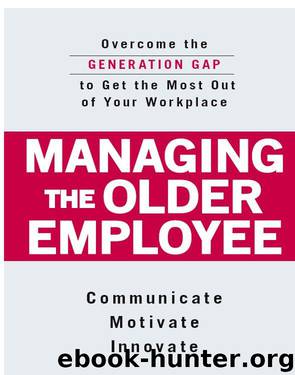Managing the Older Employee by Casey Hawley

Author:Casey Hawley
Language: eng
Format: epub
Tags: ebook, book
Publisher: Adams Business, an imprint of Adams Media, Inc.
Published: 2009-07-15T00:00:00+00:00
CHAPTER 6
Motivating Older Workers for
High Performance
Successful managers achieve employee motivation and development through two ways. One is through effectively directing the performance of older workers. The other is through precise management communication opportunities—meetings, career development, feedback, and performance appraisals.
Effectively Directing the Performance of Older Workers
Before we get into some serious strategies for motivating older workers, would you like to experience a Julia Roberts moment? I have some good news for younger managers. Your Boomer employees like you. They really like you.
So you are starting with an advantage. You have employees who are predisposed to want to do what you ask. They are more receptive to you than anyone ever predicted. They are open to receiving direction and leadership from Generation X and Y and think you are awfully good at your job. This is despite the fact that all kinds of dire predictions had abounded before 2000 as human resource planning experts prepared the workplace to have four generations working alongside one another for the first time in history. Instead, statistics show that older workers are fair in the way they judge younger managers and supervisors. You can count on being evaluated on your merits, and the good news is that younger leaders are faring quite well when evaluated by Boomers. The highest incident of unsolicited feedback received on the XYBoom Survey was that Gen-XY managers really enjoyed working with their Boomer employees, often preferring them to younger workers.
Given that you are in a great starting position, what are some approaches to use when you are faced with motivating older workers to achieve increasingly challenging levels of performance?
The Families and Work Institute (FWI) investigated this area, using 2002 data from a large and representative sample of the US workforce, and found that older employees (over age 57) who have appreciably younger supervisors are more likely to feel that their supervisors are more competent, more supportive of their success on the job, and more responsive to their personal and family needs than younger employees (Gen-X and Boomers) who have substantially younger supervisors.
—Frank Giancola,
“The Generation Gap: More Myth than Reality”
Snapshot of a Boomer Employee’s Motivators
According to Morris Massey, the godfather of managing generational differences, Boomers value the following:
• Competition: Boomers value peer competition and can be seen by others as being egocentric.
• Change: Boomers thrive on possibilities and constant change.
• Hard Work: Boomers started the “workaholic” trend. The difference between Traditionalists and Boomers is that Boomers value the hard work because they view it as necessary for moving to the next level of success while Traditionalists work hard because they feel that it is the right thing to do.
• Success: This generation is committed to climbing the ladder of success.
• Body Language: Boomers are the show-me generation and body language is important.
• Teamwork: This group embraces a team-based approach to business—they are eager to get rid of the command and control style of their Traditionalist predecessors.
• Anti Rules and Regulations: They don’t appreciate rules for the sake of having rules and they will challenge the system.
Download
This site does not store any files on its server. We only index and link to content provided by other sites. Please contact the content providers to delete copyright contents if any and email us, we'll remove relevant links or contents immediately.
Hit Refresh by Satya Nadella(9038)
The Compound Effect by Darren Hardy(8808)
Change Your Questions, Change Your Life by Marilee Adams(7635)
Nudge - Improving Decisions about Health, Wealth, and Happiness by Thaler Sunstein(7615)
The Black Swan by Nassim Nicholas Taleb(7010)
Deep Work by Cal Newport(6879)
Daring Greatly by Brene Brown(6445)
Rich Dad Poor Dad by Robert T. Kiyosaki(6401)
Principles: Life and Work by Ray Dalio(6210)
Man-made Catastrophes and Risk Information Concealment by Dmitry Chernov & Didier Sornette(5921)
Playing to Win_ How Strategy Really Works by A.G. Lafley & Roger L. Martin(5919)
Digital Minimalism by Cal Newport;(5664)
Big Magic: Creative Living Beyond Fear by Elizabeth Gilbert(5610)
The Myth of the Strong Leader by Archie Brown(5425)
The Slight Edge by Jeff Olson(5346)
Discipline Equals Freedom by Jocko Willink(5285)
The Motivation Myth by Jeff Haden(5156)
Stone's Rules by Roger Stone(5026)
The Laws of Human Nature by Robert Greene(4998)
